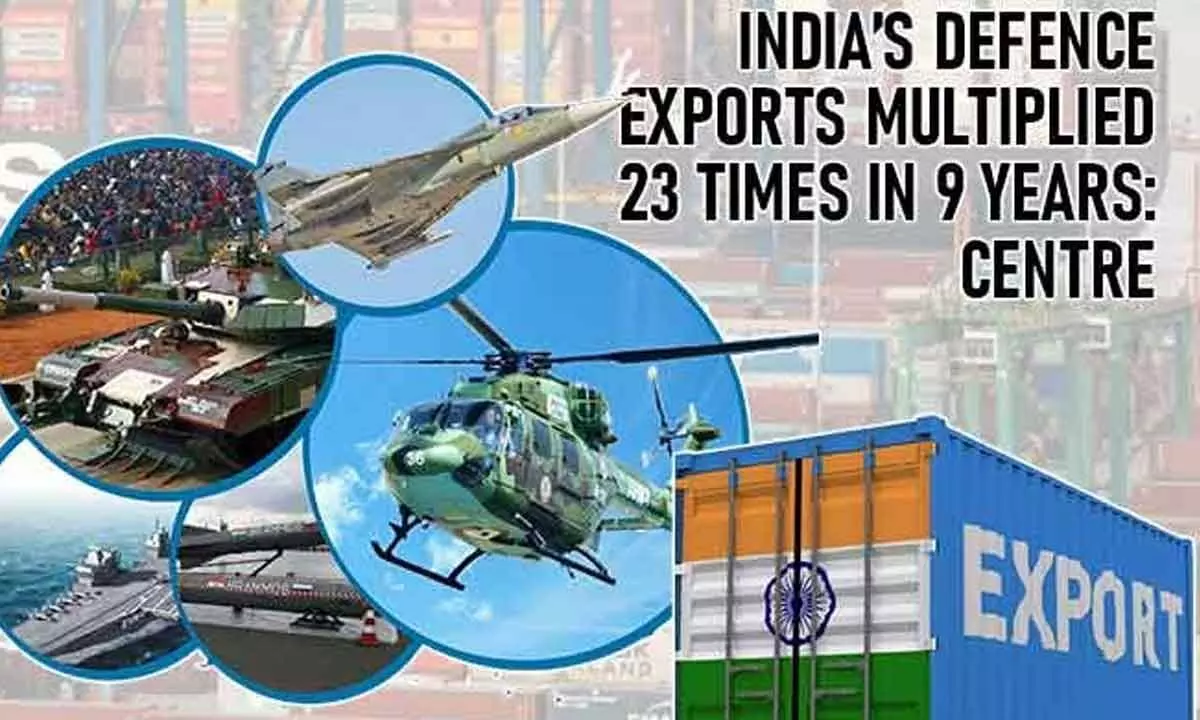The skyrocketing figures of Indian defence exports is a good augury
India is currently asserting itself on the global stage with a proactive foreign policy
image for illustrative purpose

For FY 2024-25, the government had set an ambitious target of $5 billion for India’s defence exports, up from the current $1.5 billion. It has also set an ambitious target of increasing total annual defence production to Rs. three lakh crore by 2028-29, almost three times the current level
India's defence exports have not just increased but surged to a record-breaking Rs. 21,083 crore in the fiscal year 2023-24, which translates to a remarkable 32.5% increase compared to the previous fiscal’s Rs. 15,920 crore. The growth trajectory over the last decade is even more striking—defence exports have soared 21-fold, from Rs. 4,312 crore during 2004-05 to 2013-14 to a staggering Rs. 88,319 crore from 2014-15 to 2023-24.
This surge in defence exports is not a mere coincidence. It's a result of a robust government drive towards indigenisation, a strategic move aimed at attaining self-sufficiency in defence. The government claims this drive aligns with India's aspirations for a more prominent strategic role on the global stage. The swift expansion in defence manufacturing and exports has propelled several PSU defence stocks to unprecedented highs.
The growth in the defence industry has been led by the private sector, a testament to their capabilities and contributions. However, it's important to note that defence PSUs have also played a significant role, contributing about 40% of the overall growth. This collaborative effort has been instrumental in the industry's success.
Make-in-India story:
India's 'Make in India' programme has made significant strides in the field of defence production. In a span of less than 10 years, India has not only achieved self-sufficiency in the manufacture of numerous defence items but has also emerged as a major exporter of arms. What's noteworthy is that PSUs, often criticised for their inefficiency and delays, have played a significant role in this accomplishment. India is working towards building a massive defence-industrial complex, which includes big corporations like L&T, Solar, Bharat Forge, Mahindra, Tata, and Adani, as well as startups, research bodies and PSUs.
This is a collaborative effort of nearly 50 Indian companies that manufacture ballistic missiles such as BrahMos, fighter jets, artillery guns, shells, and night-vision devices across public and private sectors. These firms are actively exporting defence products. They showcased commendable innovation, effectiveness, and quality benchmarks, which have been the significant driving forces behind this achievement and in India getting acknowledged as a trustworthy defence equipment and technology provider.
It is crucial for India to attain self-sufficiency in defence and reduce its dependence on imported military equipment in order to preserve its strategic independence. Consider a scenario where a country relies on other nations for basic military requirements like appropriate clothing for harsh climates.
The conflict between Russia and Ukraine highlighted the importance of self-reliance in defence systems, as western nations scrambled to supply weapons to Ukraine while Russia struggled to obtain military supplies from other countries. For India, which is currently asserting itself on the global stage with a proactive foreign policy, achieving defence indigenisation is even more critical.
India has taken several policy initiatives to reduce its reliance on foreign suppliers by leveraging the design and manufacturing capabilities of public enterprises, large business conglomerates, and startups. One of the significant policy initiatives is the creation of positive indigenisation lists and the allocation of 75% of the capital acquisition budget for procurement from local companies.
The government has approved nearly 45 domestic companies/joint ventures operating in the defence sector with foreign OEMs (original equipment manufacturers) and launched the Innovations for Defence Excellence (iDEX) scheme. This scheme aims to establish an ecosystem that promotes innovation and technology development in defence by engaging R&D institutes, academia, industries, startups, and even individual innovators.
The Ministry of Defence has released five ‘positive indigenisation’ lists of 4,666 items, including raw materials, sub-assemblies, critical spares, assemblies, and components. Out of these, 2,920 items have already been indigenised. Around 40 to 50 licences are granted every year in defence production. Some of the significant defence items that are being exported, other than the high-value BrahMos missile systems, include Dornier-228 aircraft, ALH helicopters, armoured vehicles, radars, SU avionics, launchers, rockets, night-vision monocular and binocular, weapons-locating radar, fire-control systems, lightweight torpedo, alarm monitoring and control systems, coastal surveillance radars, explosives, and artillery systems.
Ambitious export target:
For FY 2024-25, the government has set an ambitious target of $5 billion for India’s defence exports, up from the current $1.5 billion. It has also set an ambitious target of increasing total annual defence production to Rs. three lakh crore by 2028-29, almost three times the current level. The target for defence exports has also been set at Rs. 50,000 crore, more than double the current figure of Rs. 21,083 crore.
India has been actively trying to increase its defence exports and build relationships with several countries in Southeast Asia and the Middle East through the sale of its made-in-India BrahMos supersonic missiles. With significant interest from these countries, including a large order from the Philippines, India could potentially earn $3 billion by 2026. Additionally, India has been promoting its indigenously built light-combat Tejas fighter jet but has yet to find a customer.
Recently, Guyana received HAL-228 aircraft from India's defence forces. India is also looking to export fighter jet engines in the future, as the engine manufacturing agreement between GE Aerospace and Hindustan Aeronautics (HAL) for the GE 414 engine will power future Tejas variants.
Although the country’s defence sector is expected to experience significant growth in the coming years, there are some risks that could hinder progress. They include technology becoming obsolete and limitations in management bandwidth. Nevertheless, the sector could still achieve exponential growth with proper strategies and strong government support, leading to both economic and strategic advancements.
(The writer is a journalist who writes on defence, strategic affairs and technology)

